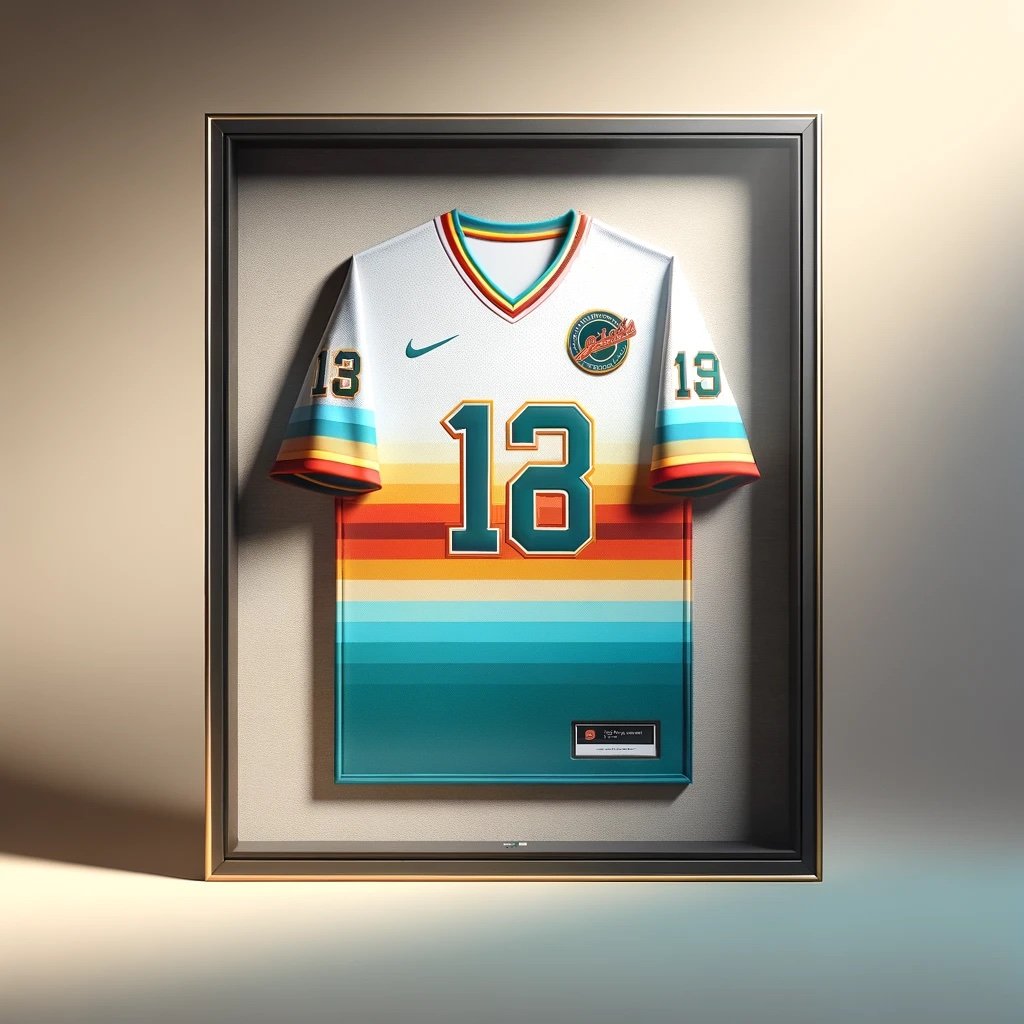How to Frame a Sports Jersey
Welcome to the world of DIY creativity, where your cherished sports jerseys transform from mere fabric to framed masterpieces. Imagine walking into a room and seeing your favorite team's jersey, not just hanging, but elegantly showcased like a priceless work of art.
In this guide, we're diving into the surprisingly simple yet profoundly satisfying journey of framing a jersey. Whether it's a treasured memento from a legendary game or a beloved player's signed jersey, we'll guide you through each step, turning your sports memorabilia into a stunning display that tells a story and ignites passion.
How to Frame a Jersey: An Overview
To frame a jersey, first gather all the necessary supplies, which usually include a shadow box frame, acid-free mat board, fabric pins, and a ruler or measuring tape. Begin by ironing or steaming your jersey to eliminate any wrinkles and to ensure it looks its best. We've included a more detailed materials list and steps below.
Materials You'll Need to Frame a Jersey
To frame a jersey, you'll need The materials needed for framing your own jersey (other than the jersey itself, of course) include:
- Either a shadow box frame or standard frame
- Mat board (if using a shadow box)
- Foam backing board (if using a standard frame)
- Plexiglass or Acrylic (if using a standard frame)
- Measuring tape
- Needle
- Thread
- Pins
- Foam insert (optional)
Frame a Jersey in 5 Steps

Step 1: Gather Necessary Supplies
- Shadow box frame or standard frame
- Acid-free mat board (for shadow box)
- Foam backing board (for standard frame)
- Plexiglass or Acrylic (for standard frame)
- Measuring tape, needle, thread, pins
- Optional foam insert
Step 2: Measure Your Jersey
- Determine the right frame size, typically 30”x36” or 32”x40”
- Bring the jersey when shopping to ensure a proper fit
Step 3: Prepare the Jersey for Display
- Iron or steam the jersey to remove wrinkles
- Lay it on the mat board (shadow box) or foam backing board (standard frame)
- Fold to display key features like the number and player name
- Use a foam insert for a fuller look, if desired
Step 4: Secure the Jersey in Position
- Pin the jersey in the desired position
- Iron the folds to maintain the shape
- Stitch the jersey to the backing board at key points
Step 5: Finalize the Framing
- For a shadow box, close it securely and hang
- For a standard frame, handle the Plexiglass carefully, removing protective film and ensuring alignment
What Jersey Frame Size Do I Need?
Start off by measuring your jersey which will make it much easier to find the right frame size. Most jerseys will either be 30” by 36” or 32” by 40”. It’s also a good idea to bring your jersey with you while shopping for your shadow box or standard frame. This way, you can lay it out in the store to ensure it’s the right fit for your jersey and that you can adequately display the important parts, e.g., the number, the name, etc.
If you’re purchasing a standard frame, make sure there is a foam backing board and the glass is plexiglass or acrylic. It may be easier to use a shadow box, as it provides more space between the object and the glass.
How Should I Display the Jersey?
Once you’ve decided on the frame or shadow box, it’s time to figure out how you want to display the jersey. Lay the jersey on either the mat board (shadow box) or foam backing board (standard frame), and fold the jersey, making sure the number, player name, and sleeve patch logos are visible. Some collectors will use a foam insert, which makes the jersey look more filled out. If you choose to use a foam insert, make sure it’s cut in a rectangular shape that fits snugly in the torso of the jersey, leaving room to fold the arms.
After making sure the jersey looks exactly how you want it to be displayed, pin the fabric in the desired position. Next, iron on the folds you made on the jersey to make sure it stays in place.
Securing the Jersey in the Frame
After you’ve ironed the folds of the jersey, take those same pins that you used to hold the folds in place and pin the jersey to the backing of either the mat board or foam backing board. It’s recommended that you use stainless steel framing pins, because they don’t rust—which will keep your jersey from damage.
Take a needle and thread and stitch the jersey to the backing board below the neckline, at the start of each sleeve, and on the bottom hem of the jersey. Make sure the stitching goes through the back of the jersey, so you can’t see the stitched lines when it’s finished. If you use an embroidery sewing needle with clear thread, it’s not quite as visible.
Next, knot the ends of the thread and use tape to make sure they are secure and won’t come unknotted once the jersey is hanging.
Final Steps
If you’re using a shadow box, simply close the box securely, and then hang it on your wall.
If you’re using a standard frame, there are a few more extra steps pertaining to the glass and the frame itself. The plexiglass will come with protective film on each side of the glass. Remove the film from one side and lay that side down on top of the jersey, making sure it’s perfectly straight before moving on to the next step. Once you’re sure it’s straight, it’s safe to remove the film from the other side of the plexiglass and frame.
What Type of Frame Should I Use to Showcase My Jersey?
It's recommended to use a shadow box frame for displaying a jersey. Shadow box frames are deep enough to accommodate the bulk of the jersey and allow it to sit away from the glass, which is essential for preserving the fabric and any signatures it may have.
Do I Need to Iron or Steam My Jersey Before Framing it?
Yes, it's advisable to iron or steam the jersey to remove wrinkles, ensuring it looks its best in the frame. However, be cautious of the fabric and any logos or signatures on it; some materials are sensitive to heat. Always read care instructions or consult a professional if you're unsure.
What Size Shadow Box Should I Use for a Jersey?
ypically, a shadow box that is 30 inches by 40 inches works well for most sports jerseys. However, the exact size may vary depending on the jersey's size and the desired display style (e.g., folding the sleeves in or out). Measure your jersey and allow some extra space on all sides for a visually appealing display.
Written by Mark Rogers
 Mark Rogers is the President and Co-Founder of Frame Destination. With over 20 years of experience in the field, Mark has become a leading authority on framing techniques and best practices, and has earned a reputation for his innovative approaches to custom framing and frame services for photographers and artists.
Mark Rogers is the President and Co-Founder of Frame Destination. With over 20 years of experience in the field, Mark has become a leading authority on framing techniques and best practices, and has earned a reputation for his innovative approaches to custom framing and frame services for photographers and artists.